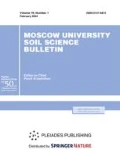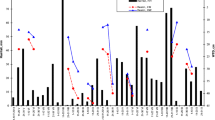Abstract
The process of natural remediation of oil- and soil-contaminated raised bogs reclaimed 14–16 years ago in Khanty-Mansiysk Autonomous Okrug–Yugra (KHMAO–Yugra) is analyzed. Revegetation is generally successful, although mesophytic grasses sown during reclamation almost completely disappeared in the grass stand. There is a gradual desalination of peat soil in salt-contaminated areas; it is accompanied by a succession change of halophytic (hemihalophytic) vegetation by communities that dominated by Calamagrostis epigeios, Eriophorum angustifolium, and Phragmites australis; a certain contribution is also made by sphagnum, green mosses, and liverworts. A characteristic feature of these habitats is the colonizing by a number of rare protected species (Heterogemma laxa, Thelypteris palustris, and Triglochin maritimum). In oil-contaminated bogs, hydrocarbons often enter from the underlying peat soil horizons during revegetation, resulting in the formation of a surface crust. Under these conditions, grass–sedge–cotton-grass and other communities are replaced by grass stands of Eriophorum angustifolium and some other species with strong root systems. A certain role in the overgrowth of crusted surfaces is also played by mosses (Sphagnum riparium, Warnstorfia fluitans, etc.). Unsuccessful restoration is observed in hollows with restricted runoff for salt-contaminated bogs and in most significantly drained segments for oil-contaminated ones.
Similar content being viewed by others
REFERENCES
Avetov, N.A., Geobotanical indication of the trophic status and moistening of reclaimed oil-polluted oligotrophic peat soils in the middle reaches of the Ob River, Eurasian Soil Sci., 2009, vol. 42, no. 1, pp. 105–109.
Avetov, N.A., Arzamazova, A.V., Kinzhaev, R.R., et al., The way to estimate oil pollution of Middle Ob River lands: methodological approaches, Probl. Agrokhim. Ekol., 2012, no. 3.
Avetov, N.A. and Shishkonakova, E.A., Oil pollution of Western Siberia bogs, Priroda (Moscow, Russ. Fed.), 2010, no. 11.
Vasil’ev, S.V., Vozdeistvie neftegazodobyvayushchei promyshlennosti na lesnye i bolotnye ekosistemy (Oil and Gas Industry Effect onto Forest and Bog Ecosystems), Novosibirsk, 1998.
Vershinin, Yu.A. and Zubaidullin, A.A., The way to estimate ecological risks under bogs pollution and recultivation, Vestn. Nizhnevart. Gos. Univ., 2009, no. 1.
Krasnaya kniga KhMAO – Yugry (Red Data Book of Khanty-Mansiisk Autonomous District – Yugra), Yekaterinburg, 2013.
Kukurichkin, V.N. and Tyurin, G.M., Some features of salt polluted areas healing at Surgut lowland bogs, Materialy 3-go Mezhdunarodnogo polevogo simpoziuma “Zapadnosibirskie torfyaniki i tsikl ugleroda: proshloe i nastoyashchee” (Proc. 3rd Int. Field Symp. Western Siberia Bogs and Carbon Cycle: Past and Present), Novosibirsk, 2011.
Kurakov, A.V., Il’inskii, V.V., Kotelevtsev, S.V., and Sadchikov, A.P., Bioindikatsiya i reabilitatsiya ekosistem pri neftyanykh zagryazneniyakh (Ecosystems Bioindication and Rehabilitation under Oil Pollution), Moscow, 2006.
Lapshina, E.D. and Bloiten, V., Distortion types and natural restoration for oligotrophic bog flora at oil depositions in Tomsk oblast, Krylovia. Sib. Bot. Zh., 1999, no. 1.
Makovskii, V.I., Oil pollution effect onto ecosystem state in Surgut Ob River Region, Ekologiya neftegazovogo kompleksa. Tez. dokl. (Proc. Ecology of Oil and Gas Complex), Moscow, 1988.
Seredina, V.P., Andreeva, T.A., Alekseeva, T.P., et al., Neftezagryaznennye pochvy: svoistva i rekul’tivatsiya (Oil Polluted Soils: Properties and Recultivation), Tomsk, 2006.
Soromotin, A.V., Vozdeistvie dobychi nefti na taezhnye ekosistemy Zapadnoi Sibiri (Oil Extraction Effect onto Western Siberian Taiga Ecosystems), Tyumen, 2010.
Tyurin, V.N., Anthropogenic dynamic of bog ecosystems under oil and salt pollution, Materialy konferentsii “IX Galkinskie chteniya” (Proc. 9th Galkin Readings), St. Petersburg, 2018.
Chizhov, B.E., Les i neft’ Khanty-Mansiiskogo avtonomnogo okruga (Forest and Oil of Khanty-Mansiisk Autonomous District), Tyumen, 1998.
Chizhov, B.E., Dolinger, V.A., and Zakharov, A.I., Oil pollution features at Khanty-Mansiisk Autonomous District, Vestn. Ekol., Lesoved. Landshaftoved., 2008, no. 8.
Shepeleva, L.F., Tarusina, E.A., Shepelev, A.I., and Frolov, V.N., Vegetational cover reclamation at oil polluted lands of Middle Ob River Region after recultivation, in Vestn. Tomsk. Gos. Univ., 2007, no. 301.
Ekologiya Khanty-Mansiiskogo avtonomnogo okruga (Ecology of Khanty-Mansiisk Autonomous District), Tyumen, 1997.
Introduction to Phytoremediation, Washington, 2000.
Johnstone, J.F. and Kokelj, S.V., Environmental conditions and vegetation recovery at abandoned drilling mud sumps in the Mackenzie delta region, Northwest Territories, Xanada, Arctic, 2008, vol. 61, no. 2.
Khaitan, S., Kalainesan, S., Erickson, L.E., et al., Remediation of site contaminated by oil refinery operations, Environ. Prog., 2006, vol. 25, no. 1.
Pouline, M., Fontaine, N., and Rochefort, L., Restoration of pool margin communities in cutover peatlands, Aquat. Bot., 2011, vol. 94, no. 2, pp. 107–111.
Sottocornola, M., Boudreau, S., and Rochefort, L., Peatbog restoration: effect of phosphorous on plant re-establishment, Ecol. Eng., 2007, vol. 31, no. 1, pp. 29–40.
Trinder, C.J., Artz, R.R.E., and Johnson, D., Contribution of plant photosynthate to soil respiration and dissolved organic carbon in the naturally recolonizing cutover peatland, Soil Biol. Biochem., 2008, vol. 40, no. 7, pp. 1622–1628.
Whisenant, S.G., Repairing Damaged Wildlands: a Process-Oriented Landscape-Scale Approach, Cambridge, 1999.
Funding
This study was partly performed within the framework of the research topics: “Productivity of Agroecosystems and Its Relationship with the Dynamics of Soil Fertility,” no. 116020350086-4; “Land Use and Soil Mapping Based on Geographic Information Systems,” no. 115122210043; and a grant of the Ministry of Education and Science of Russia (agreement no. 05.607.21.0302).
Author information
Authors and Affiliations
Corresponding authors
Ethics declarations
Conflict of interests. The authors declare that they have no conflicts of interest.Statement on the welfare of humans or animals. This article does not contain any studies involving animals performed by any of the authors.
Additional information
Translated by D. Zabolotny
About this article
Cite this article
Shishkonakova, E.A., Trofimov, S.Y., Avetov, N.A. et al. Restoration of Raised Bogs in the Khanty-Mansiysk Ob Region after Reclamation of Oil- and Salt-Polluted Peat Soils in 2003–2005. Moscow Univ. Soil Sci. Bull. 75, 123–130 (2020). https://doi.org/10.3103/S0147687420030059
Received:
Revised:
Accepted:
Published:
Issue Date:
DOI: https://doi.org/10.3103/S0147687420030059




